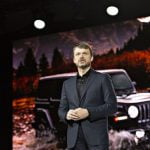
UNDER THE WARM ASPHALT of West Los Angeles, beneath bumper-to-bumper traffic and swaying palm trees, Elon Musk is searching for answers. There, a boring machine named Godot may soon grind away at a 2.7-mile tunnel to run below Interstate 405, a key reason that L.A. retains its crown as the U.S. city with the worst traffic.
The tunnel currently awaits a permit, and Angelenos may be waiting a while before it’s complete. (Paging Vladimir and Estragon.) But Musk, who spends his days juggling CEO roles at electric-auto maker Tesla and aerospace outfit SpaceX, has something to prove. Practically speaking, the Bel Air resident wants easier transit between his homes and the SpaceX campus in Hawthorne, 17 miles to the south. From a theoretical standpoint, Musk hopes to demonstrate that subterranean, supersonic public transit isn’t just a futuristic fantasy but a realistic solution for what ails many of America’s busiest (and most cash-strapped) metropolises.
Enter Musk’s cleverly named Boring Company. It has announced projects to connect Baltimore with Washington, D.C. (a 35-mile span), and downtown Chicago with O’Hare International Airport (a 17-mile stretch). In Chitown, the Chicago Express Loop promises to ferry passengers from one end to the other in 12 minutes—far less time than the usual 25 to 90, depending on the mode of transportation. This Loop—not to be confused with Hyperloop, an ultrafast, regional version—boasts electromagnetic pods that each fit 16 passengers and can reach speeds of 150 miles per hour. It plans to transport nearly 2,000 people an hour in each direction, with cars departing every 30 seconds to two minutes.
But it’s not just technology that the Boring Co. is bringing to the table. Unlike other urban projects of this size, no government funding is necessary to realize the Chicago project: The Boring Co. promises to privately fund the entirety of what will likely be a multibillion

dollar effort. And thanks to a City of Chicago request for proposals, the plan has a complete go-ahead from officials—unlike the L.A. and D.C. projects, which face some time in legal limbo. That makes the Chicago Express Loop the Boring Co.’s first sizable victory and strongest validation from a city government to date, in what could be a path forward for future advancements in public infrastructure.
“Let’s face it—federal support for urban rail projects is not likely to bounce back anytime soon,” says Joe Schwieterman, director of DePaul University’s Chaddick Institute for Metropolitan Development. “Cities will be left to fend for themselves, making it critical that they remain open to private-sector collaboration.”
Major U.S. cities face a chronic shortfall in capital investment dollars. With 35,000 daily passengers projected to move between the airport and downtown in 2045, Chicago is left with little choice but to leverage the private sector—and take a chance on Musk—to fill mobility gaps. But there are risks to placing public projects in private hands, warns Yonah Freemark, the urbanist behind The Transport Politic. In Chicago, for example, residents remain in the dark about the technical and economic feasibility of the Boring Co. project.
“The public sector is allowing the company to move forward with this project without actual consideration from the public,” Freemark says. “That should be concerning for people who want to be involved in the transit future of their communities.”
Elsewhere, regulatory hurdles and governmental requests—such as for environmental analysis and public hearings—have stifled the progress of Boring Co. projects in California and Maryland. “The signal systems, federal approvals required to put people on these vehicles, and the need for elevators and ventilation shafts when digging long distances beyond the surface—those are really big questions that are going to need answers,” Schwieterman says. (The Boring Co. declined to comment.)
Still, Musk bores ahead. If he is successful in Chicago, elected officials across the country might be inclined to take a similar leap of faith. After all, if Musk can shoot for Mars, what’s a little bedrock between friends?
A version of this article appears in the August 1, 2018 issue of Fortune with the headline “Elon Musk’s Most Exciting Company Is Boring.”
[“Source-fortune”]




